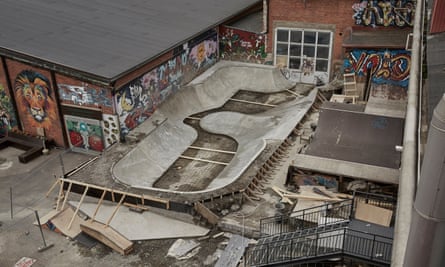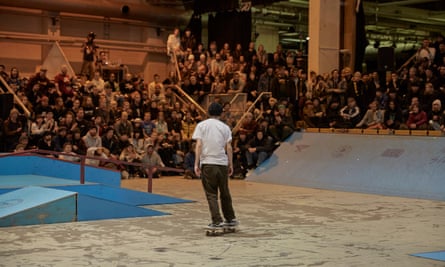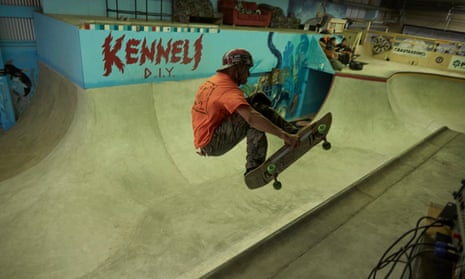There’s little to distinguish Tampere from hundreds of other post-industrial small towns and cities across the global north. With a population of 232,000, it is Finland’s second-largest urban area, known as the Manchester of Finland due to its past as an industrial powerhouse. And like many other towns and cities, after a century of prosperity the decline of industry left Tampere facing an existential crisis. It now counts its major claims to fame as mustamakkara (a black sausage) and the world’s only Moomin museum.
Although Finland consistently places at the top of global rankings in everything from income to equality to education, the collapse of its major trading partner, the Soviet Union, in 1991 left the country struggling with unemployment, particularly among the young. Tampere was not immune. The global financial crisis compounded Finland’s problems; youth unemployment in the Pirkanmaa region, which includes Tampere, hit 28% in 2009.
Alienation and even radicalisation became a serious issue, and most young Finns know someone who has slipped down the path into alcoholism. The city was struggling to find a strong identity and purpose – and like many smaller places it was also victim to a gravitational pull on talent, investment and resources from a much bigger city: in Tampere’s case, Helsinki.

Although many of Tampere’s old factories are architectural marvels, as abandoned buildings they can create giant “ghost zones”, and all too easily transform into centres for drug-taking, vagrancy and crime.
Tampere is emblematic of changes across Finland: as industries close, forestry becomes increasingly mechanised and the population both ages and shrinks, young Finns often grow up bored and frustrated, killing time until they leave for the big cities. Census figures suggest the population of non-metropolitan areas will shrink by 180,000 over the next 20 years. For young people in smaller cities, it can be particularly hard to imagine a positive future.
That’s why the ramp dogs are here.
In a sprawling yard below an old pulp mill beside Lake Näsijärvi, near the city, members of Kaarikoirat (“Ramp Dogs”), a self-organised association of skateboarders , are hard at work, pouring concrete and smoothing out a gradient over a hand-built wooden frame.

“I have so many friends who are stuck,” says Ville Natunen, a Kaarikoirat member and now a professional skatepark builder with the Canadian firm Beaver Concrete. “They’re unemployed, they get passive and depressed. Eventually, they stop believing they can do anything.”
In 2010 Kaarikoirat members decided to take matters into their own hands. Fed up with their calls for municipal investment in skateboarding meeting with indifference, they set about building a skatepark of their own, called Tikkutehdas DIY, in the ruins of an old matchstick factory. None of them had any prior construction experience, but each day more young people – many of whom the state and NGOs had previously failed to engage – began showing up to lend a hand.
“In the beginning, there was no contact with the city’s decision-makers,” recalls founder Teemu Grönlund. “Skateboarding had no spokesperson. But we didn’t sit around and complain; we worked hard, by hand, to make our dreams come true.”

In 2015, after endless meetings and proposals a second project, Iso-Vilunen, became the biggest outdoor concrete skatepark in Finland. The same year, Kaarikoirat got permission to build a mini-ramp under a bridge in the heart of the city. Then it convinced the city to move unused granite blocks to create a new skate plaza in a park that had formerly been used primarily by problem drinkers. The skate plaza brought in families, reactivating a previously unloved outdoor social space, and helped to turn the little-used public stage in the park into a lively spot for events and gigs – all at almost no cost to the city.
“What Kaarikoirat has achieved really captures the power of this emerging self-organised and action-based approach,” says Timo Hämäläinen, an urban policy adviser. “They proved that facilities for the skateboarding community make social life better for everyone – all with no assistance from the city; without any power, resources or allies.”

Today, Kaarikoirat does have the backing of the city of Tampere. After years of concerted pressure, it has become an important ally in helping the municipality achieve its own stated objectives, from increasing civic participation to urban regeneration and reducing youth unemployment.
In 2016, the government handed Kaarikoirat the keys to a 680 sq metre factory building next to Lake Näsijärvi that was once the centre of a major forestry industry. With the local job centre covering salaries, the ramp dogs went to work on an enormous indoor concrete bowl, Kenneli DIY. It now hosts a wide range of cultural events, from music festivals to Trelogy, one of the biggest skateboarding events in the Nordic countries.
Many of the ramps are branded with “Visit Tampere”, an ongoing partnership with the official tourism body, which provides funding in return for use of content produced by the skateboarders, allowing it to market Tampere as a young, exciting and culturally significant city. Even city hall – a boxy, modernist building that looks out over a Lutheran church – has a huge poster of skateboarders on its ground-floor window, demonstrating how deeply skating has been integrated into Tampere’s brand.

Kaarikoirat also explicitly reaches out to young people. In 2017 it started offering three- to six-month placements to young people, who receive a boost to their unemployment benefit for the duration and are taught about all aspects of the organisation, helping out with the day-to-day operation or specific projects. Some are then hired by Kaarikoirat for up to a year, building, doing publicity, running events or developing projects, with the state supporting their salary. Kaarikoirat also helps facilitate internships and projects that offer academic credits for carpentry, 3D printing and modelling.
“Tampere’s industrial heritage is our roots, but we have been forced to recreate our story,” says the deputy mayor Anna-Kaisa Heinämäki. “We face tough competition from Helsinki in all areas.” Making the city attractive to young people is key, she says. “I believe our openness to collaborations with students and organisations such as Kaarikoirat has been crucial. The typical citizen of Tampere is 24 years old; so delivering services and facilities they want requires us to be innovative and listen to all kinds of new ideas.
“A big question for society is: how does government collaborate successfully with these initiatives with deep roots in the local community; maturing and scaling them, to reach more unemployed young people? Yet, if too much government gets involved, things become more official and all the fun is gone. We don’t know what works yet, so we’re going to have to explore different models.”

Certainly the success of Kaarikoirat suggests that, rather than expensive, large-scale developments in the city centre like casinos and skyscrapers, it is micro-initiatives that offer smaller cities the best chance of catalysing a vibrant urban fabric and preventing brain drain to the likes of Helsinki. For such cities, the future seems to lie in cultivating a unique identity and empowering citizens to solve problems.
“Embracing DIY urbanism could play a significant role in giving smaller cities an edge – although it’s hard to say how significantly, because this is still a new phenomenon,” Hämäläinen says. “Bureaucratic, siloed structures are a relatively recent development – historically, cities built with a very organic, DIY practice has made them successful and sustainable over time.”
Follow Guardian Cities on Twitter, Facebook and Instagram to join the discussion, catch up on our best stories or sign up for our weekly newsletter

Comments (…)
Sign in or create your Guardian account to join the discussion